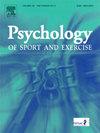Physical activity identity as an axis of dual process motivation and self-regulation processes: Current evidence and future research directions
IF 3.3
2区 心理学
Q2 HOSPITALITY, LEISURE, SPORT & TOURISM
引用次数: 0
Abstract
Regular physical activity (PA) has considerable health, social, and environmental benefits, yet many people participate in less PA than recommended. Understanding the factors driving PA participation is critical for promotion. Many theoretical approaches, across several traditions, have been applied to understand and change PA with modest success, demonstrating room for theoretical innovation. The purpose of this critical review was to overview the application of identity theory, as one potential domain of theoretical innovation for understanding and changing PA, while emphasizing several pertinent areas to advance theoretical and applied research. Contemporary evidence shows that the relationship between PA identity and behavior is sizeable, and comparable to many of the most well-researched PA correlates (e.g., intention, self-efficacy, habit). PA identity and behavior also covary over time, and the dual-process and self-regulatory control system often proposed for how identity may drive PA has preliminary support. Despite this evidence, we suggest that refined testing of the identity control system with a particular emphasis on the affect-behavior connection is needed. Research on the forms of motivation (automatic, reflective) and self-regulation processes that drive this system also require more research, which may benefit from refinement of measurement of identity and its associated processes, including applications in real time (e.g., ecological momentary assessment). Integration of PA identity into a cohesive model and/or within well-established PA theories is still needed, and advancing our understanding and effectiveness of PA identity change through interventions should be an ongoing research direction.
体育活动认同作为双过程动机和自我调节过程的轴:现有证据和未来研究方向。
有规律的体育活动(PA)对健康、社会和环境都有相当大的好处,但许多人的运动量低于推荐量。了解推动PA参与的因素对推广至关重要。跨越几个传统的许多理论方法已经被应用于理解和改变PA,并取得了一定的成功,这表明理论创新的空间。这篇批判性综述的目的是概述身份理论的应用,作为理解和改变PA的理论创新的一个潜在领域,同时强调几个相关领域来推进理论和应用研究。当代证据表明,个人动机认同与行为之间的关系是相当大的,可以与许多研究得最充分的个人动机相关因素(如意图、自我效能、习惯)相媲美。PA身份和行为也随时间而变化,通常提出的双重过程和自我调节控制系统对身份如何驱动PA有初步支持。尽管有这些证据,我们建议需要对身份控制系统进行精确的测试,特别强调情感-行为之间的联系。对驱动这一系统的动机形式(类型1、类型2)和自我调节过程的研究也需要更多的研究,这可能受益于对身份及其相关过程的测量的改进,包括实时应用(例如,生态瞬时评估)。将PA身份整合到一个有凝聚力的模型和/或完善的PA理论中仍然需要,通过干预提高我们对PA身份变化的理解和有效性应该是一个持续的研究方向。
本文章由计算机程序翻译,如有差异,请以英文原文为准。
求助全文
约1分钟内获得全文
求助全文
来源期刊
CiteScore
6.40
自引率
5.90%
发文量
172
审稿时长
69 days
期刊介绍:
Psychology of Sport and Exercise is an international forum for scholarly reports in the psychology of sport and exercise, broadly defined. The journal is open to the use of diverse methodological approaches. Manuscripts that will be considered for publication will present results from high quality empirical research, systematic reviews, meta-analyses, commentaries concerning already published PSE papers or topics of general interest for PSE readers, protocol papers for trials, and reports of professional practice (which will need to demonstrate academic rigour and go beyond mere description). The CONSORT guidelines consort-statement need to be followed for protocol papers for trials; authors should present a flow diagramme and attach with their cover letter the CONSORT checklist. For meta-analysis, the PRISMA prisma-statement guidelines should be followed; authors should present a flow diagramme and attach with their cover letter the PRISMA checklist. For systematic reviews it is recommended that the PRISMA guidelines are followed, although it is not compulsory. Authors interested in submitting replications of published studies need to contact the Editors-in-Chief before they start their replication. We are not interested in manuscripts that aim to test the psychometric properties of an existing scale from English to another language, unless new validation methods are used which address previously unanswered research questions.

 求助内容:
求助内容: 应助结果提醒方式:
应助结果提醒方式:


